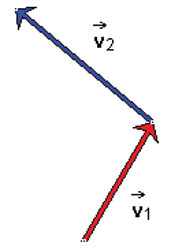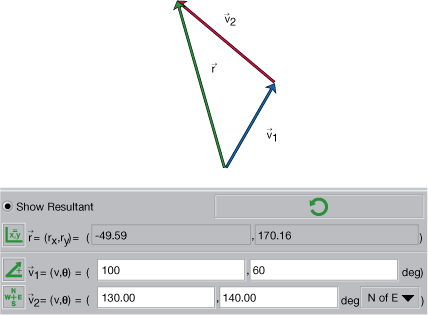Module 2—Motion in Two Dimensions
 Lesson 2 Lab: Numerical Vector Addition
Lesson 2 Lab: Numerical Vector Addition
Introduction
In the example of the commercial aircraft flight between Calgary and Vancouver in Get Focused, there are two different velocities that contribute to the ground velocity:
-
air velocity, which is the plane’s velocity relative to the air
-
wind velocity, which is the wind’s velocity relative to the ground
Adding these two vectors is not as straightforward as it may seem. If the air velocity is 10.0 m/s and the wind velocity is 5.0 m/s, and they are not moving in the same direction, the plane’s ground velocity will not be 10.0 ms + 5.0 m/s = 15.0 m/s. You must add the two velocities as vector quantities with both a magnitude and direction.
The simulation used for this lab adds two or more vectors. It will help you to calculate the magnitude and direction of the sum of two vectors. You can learn more about the simulation and how to use it by reading the Show Me found at the top of the simulation screen.
Problem
How do you determine and illustrate the sum of two vectors?
Open the Vector Addition: Numerical simulation; adjust the margins, if needed, so the black areas are minimized.
Procedure
The simulation will be used to determine a plane's velocity relative to the ground when both the wind velocity and the air velocity are known. For example, how would you determine the ground velocity of a plane that is flying with an air velocity of 130 m/s at 140° in the polar direction while the wind velocity is 100 m/s at 60°?

-
If the window shows more than two vectors, clear it by pressing the “Reset” button (
 ).
).
-
Enter the first vector,
 , with a magnitude of 100 m/s at an angle of 60° in the polar (positive) mode (
, with a magnitude of 100 m/s at an angle of 60° in the polar (positive) mode ( ).
).
-
Enter the second vector,
 , with a magnitude of 130 m/s at an angle of 140° in the polar (positive) mode (
, with a magnitude of 130 m/s at an angle of 140° in the polar (positive) mode ( ), and drag both vectors to the centre of the screen.
), and drag both vectors to the centre of the screen.
- After entering the two vectors, click the “Show Resultant” button labelled to display the resultant (sum of the vectors). If you use the polar (positive) mode (
 ) for the resultant, you should see a display similar to that below.
) for the resultant, you should see a display similar to that below.

According to the simulation, the plane's velocity relative to the ground would be 177.24 m/s at 106.25°.
Observation and Analysis
LAB 1. Choose the correct answer below. The graphical construction of the resultant illustrates the
- tip-to-tail method of vector addition
- parallelogram method of vector addition
LAB 2. The resultant may be displayed in three modes. Click the “Mode Toggle” button (![]() ) for the resultant,
) for the resultant, ![]() , three times to cycle to the Cartesian mode (
, three times to cycle to the Cartesian mode (![]() ). In this mode the resultant’s x and y components (rx, ry) are displayed as shown below.
). In this mode the resultant’s x and y components (rx, ry) are displayed as shown below.
Button |
Mode |
Example |
| magnitude and polar positive direction (r, θ) | ||
magnitude and navigational direction (r, θ .E of N) |
||
Cartesian components (rx, ry) |
Using the “Mode Toggle” button, describe the plane’s velocity relative to the ground using all three modes.
- The magnitude and polar (positive) direction of the resultant (
 ) is ( _______ , ________ deg).
) is ( _______ , ________ deg).
- The magnitude and navigational direction of the resultant (
 ) is ( ________ , ________ E of N).
) is ( ________ , ________ E of N).
- The Cartesian components of the resultant (
 ) are ( ________ , ________).
) are ( ________ , ________).
How is the resultant being calculated? One common method is to analyze and add the vector components.
Calculating a Resultant Vector Using Vector Components

You will now calculate the sum of the same two vectors, ![]() and
and ![]() , using component analysis.
, using component analysis.
For the following calculations, you will need to know the components of a vector.
It is particularly easy if the vectors are already given in terms of their x and y components, (vx, vy)1 and (vx, vy)2.
However, what if the vectors are given in terms of magnitude and direction
[(v1, Θ1) and (v2, Θ2)]?
Angles are measured in the polar (positive) specification (or navigation N of E).
The magnitude and direction of ![]() and
and ![]() are
are
-
v1 = 100 m/s, θ1= 60°
-
v2 = 130 m/s, θ2= 140°
Open the Component Vector Addition simulation. It will show you in detail how to calculate the resultant. When you have read a screen, click the “Next” arrow to go on. On screens 7 to 9, when the symbols show vfx and vf, they really mean v1x and v1.